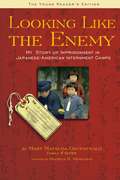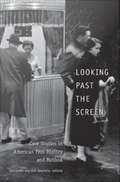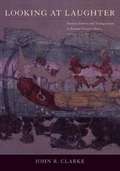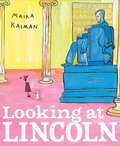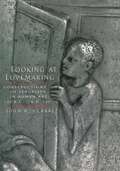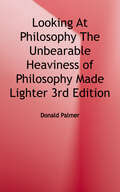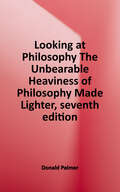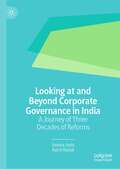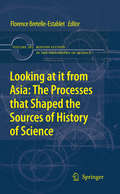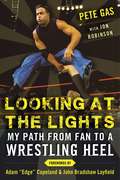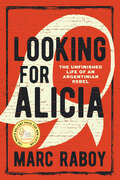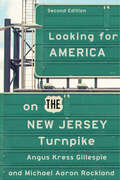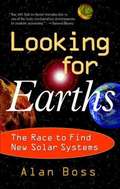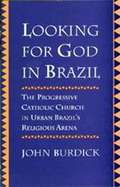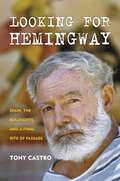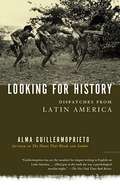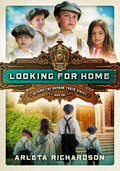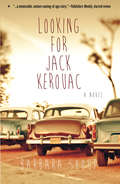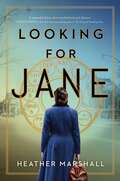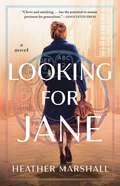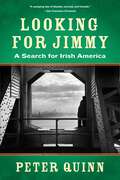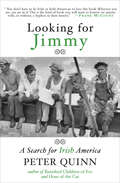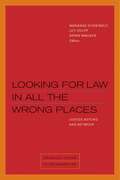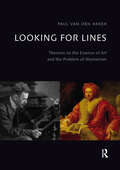- Table View
- List View
Looking Like the Enemy (The Young Reader's Edition)
by Maureen R. Michelson Mary Matusda GruenewaldMary Matsuda is a typical 16-year-old girl living on Vashon Island, Washington with her family. On December 7, 1942, the Japanese bomb Pearl Harbor, and Mary's life changes forever. Mary and her brother, Yoneichi, are U.S. citizens, but they are imprisoned, along with their parents, in a Japanese-American internment camp. Mary endures an indefinite sentence behind barbed wire in crowded, primitive camps, struggling for survival and dignity. Mary wonders if they will be killed, or if they will one day return to their beloved home and berry farm. The author tells her story with the passion and spirit of a girl trying to make sense of this terrible injustice to her and her family. Mary captures the emotional and psychological essence of what it was like to grow up in the midst of this profound dislocation, questioning her Japanese and her American heritage. Few other books on this subject come close to the emotional power, raw honesty, and moral significance of this memoir. This personal story provides a touchstone for the young student learning about World War II and this difficult chapter in U.S. history.
Looking Past the Screen: Case Studies In American Film History and Method
by Eric Smoodin Jon LewisFilm scholarship has long been dominated by textual interpretations of specific films. Looking Past the Screen advances a more expansive American film studies in which cinema is understood to be a social, political, and cultural phenomenon extending far beyond the screen. Presenting a model of film studies in which films themselves are only one source of information among many, this volume brings together film histories that draw on primary sources including collections of personal papers, popular and trade journalism, fan magazines, studio publications, and industry records. Focusing on Hollywood cinema from the teens to the 1970s, these case studies show the value of this extraordinary range of historical materials in developing interdisciplinary approaches to film stardom, regulation, reception, and production. The contributors examine State Department negotiations over the content of American films shown abroad; analyze the star image of Clara Smith Hamon, who was notorious for having murdered her lover; and consider film journalists' understanding of the arrival of auteurist cinema in Hollywood as it was happening during the early 1970s. One contributor chronicles the development of film studies as a scholarly discipline; another offers a sociopolitical interpretation of the origins of film noir. Still another brings to light Depression-era film reviews and Production Code memos so sophisticated in their readings of representations of sexuality that they undermine the perception that queer interpretations of film are a recent development. Looking Past the Screen suggests methods of historical research, and it encourages further thought about the modes of inquiry that structure the discipline of film studies. Contributors. Mark Lynn Anderson, Janet Bergstrom, Richard deCordova, Kathryn Fuller-Seeley, Sumiko Higashi, Jon Lewis, David M. Lugowski, Dana Polan, Eric Schaefer, Andrea Slane, Eric Smoodin, Shelley Stamp
Looking at Laughter: Humor, Power, and Transgression in Roman Visual Culture, 100 B. C. - A. D. 250
by John R. ClarkeLooking at Laughter examines a heterogeneous corpus of visual material, from the crudely obscene to the exquisitely sophisticated and from the playful to the deadly serious--everything from street theater to erudite paintings parodying the emperor.
Looking at Lincoln
by Maira KalmanAbraham Lincoln is one of the first giants of history children are introduced to, and now Maira Kalman brings him to life with her trademark style and enthusiasm. Lincoln's legacy is everywhere - there he is on your penny and five-dollar bill. And we are still the United States because Lincoln helped hold them together. But who was he, really? The little girl in this book wants to find out. Among the many other things, she discovers our sixteenth president was a man who believed in freedom for all, had a dog named Fido, loved Mozart, apples, and his wife's vanilla cake, and kept his notes in his hat. From his boyhood in a log cabin to his famous presidency and untimely death, Kalman shares Lincoln's remarkable life with young readers in a fresh and exciting way.
Looking at Lovemaking: Constructions of Sexuality in Roman Art, 100 B.C. – A.D. 250
by John R. ClarkeWhat did sex mean to the ancient Romans? In this lavishly illustrated study, John R. Clarke investigates a rich assortment of Roman erotic art to answer this question—and along the way, he reveals a society quite different from our own. Clarke reevaluates our understanding of Roman art and society in a study informed by recent gender and cultural studies, and focusing for the first time on attitudes toward the erotic among both the Roman non-elite and women. This splendid volume is the first study of erotic art and sexuality to set these works—many newly discovered and previously unpublished—in their ancient context and the first to define the differences between modern and ancient concepts of sexuality using clear visual evidence.Roman artists pictured a great range of human sexual activities—far beyond those mentioned in classical literature—including sex between men and women, men and men, women and women, men and boys, threesomes, foursomes, and more. Roman citizens paid artists to decorate expensive objects, such as silver and cameo glass, with scenes of lovemaking. Erotic works were created for and sold to a broad range of consumers, from the elite to the very poor, during a period spanning the first century B.C. through the mid-third century of our era. This erotic art was not hidden away, but was displayed proudly in homes as signs of wealth and luxury. In public spaces, artists often depicted outrageous sexual acrobatics to make people laugh.Looking at Lovemaking depicts a sophisticated, pre-Christian society that placed a high value on sexual pleasure and the art that represented it. Clarke shows how this culture evolved within religious, social, and legal frameworks that were vastly different from our own and contributes an original and controversial chapter to the history of human sexuality.
Looking at Philosophy: The Unbearable Heaviness of Philosophy made Lighter
by Donald PalmerOrganized historically and augmented by more than 400 cartoons designed to make teaching and learning more fun, this lighthearted work, born of serious scholarship, can be used as a core text or as a supplement in introductory courses.
Looking at Philosophy: The Unbearable Heaviness of Philosophy made Lighter
by Donald PalmerDistilled from Donald Palmer’s more than thirty years of teaching experience, this text exemplifies his very successful approach to teaching introductory philosophy. Through the use of humor and nearly 400 drawings, charts, and diagrams, serious philosophical topics come alive for the reader without compromising the importance of the subject matter. In the author’s words, “This book takes philosophy seriously, but not gravely.”
Looking at and Beyond Corporate Governance in India: A Journey of Three Decades of Reforms
by Seema Joshi Ruchi KansilThis book explores theoretical and empirical perspectives on corporate governance and sustainability and reflects upon India’s three decades of corporate governance reforms. It provides a solid base of information culled from extensive empirical research. It will contribute to the 2030 agenda of the United Nations on Sustainable Development Goals by lighting the way forward and enhancing the convergence of corporate governance with sustainability in business entities. Adopting a credible and uniform sustainability reporting framework and cultivating a pervasive “sustainability culture” through effective “sustainability leadership” has become a business imperative. It will be highly relevant for all stakeholders, including shareholders, boards of directors, managers, academicians, and researchers, and it will empower, enrich, and enable them to gain more conceptual clarity and empirical understanding of corporate governance and sustainability issues. In addition, it shows the pathway for policymakers and practitioners to address the myriad challenges that emanate from sustainability by suggesting new approaches emerging in the critical domain of corporate governance.
Looking at it from Asia: the Processes that Shaped the Sources of History of Science
by Karine Chemla Agathe Keller Christine Proust Catherine Jami Florence Bretelle-EstabletThe idea of this volume took shape within a group of scholars working on the history of science in Asia. Despite the great differences in time, locations and disciplines between our respective fields of research, we all faced similar situations: among the huge mass of written documents available to historians and that were eventually taken as sources in the historiography of science, some had been well studied while others had been dismissed or ignored. This observation will seem obvious to historians, whose daily work consists in shaping corpuses to raise new questions. The diagnosis has long been established that such selections related to the historians' agenda and thereby reflected the ways in which historiography somehow belonged to its time. Yet, it appeared to us that this diagnosis was insufficient and that the selective consideration of source material was also at least partly related to mechanisms of selection that occurred upstream from the historian's classical work of shaping a corpus. Therefore, we came to the idea that, in order to write, or to rewrite, chapters in the history of science, historians may benefit from relying on a critical analysis of the factors that, along history, shaped the documents that have become their sources or the collections from which they constitute their corpuses. It is to the development of such a branch of critical analysis in the history of science, to its methods and to its benefits --to be illustrated in carefully chosen case studies--, that we suggest to devote a collective research and a book. We want to inquire into how the corpuses we form incorporate long sequences of selections and reorganizations that took place in history and that must be brought to light if we do not want various types of actors of the past to carve their choices and conceptions into our questions and conclusions.
Looking at the Lights: My Path from Fan to a Wrestling Heel
by Adam Copeland Jon Robinson Pete Gas John LayfieldHow did an untrained former college football player end up in the middle of a ring, wrestling during the highest-rated segment during the WWE’s acclaimed Attitude Era?That’s the story behind Looking at the Lights. As a childhood friend of Shane McMahon, Pete Gas was given the opportunity most only pray for. Beginning with appearances to interfere in McMahon’s matches, his role blossomed into becoming a full-fledge wrestler and leading the Mean Street Posse to WrestleMania, becoming one of the most fascinating success stories of the era.From his humble upbringing and friendship with Shane (and the McMahon family as a whole), Gas shares how a 9-to-5 average Joe got the chance of a lifetime and made the most out of it.But getting your foot in the door is one thing; staying is a completely different animal. With all eyes on him, knowing his lack of training and meal ticket being the boss’s son, Gas knew he had to win over all those doubters: from the fans and announcers to the wrestlers themselves.Knowing he had to prove himself, Gas took beatings, chair shots, and additional training to not only show that he could wrestle, but that he belonged with such superstars as The Rock, "Stone Cold” Steve Austin, and The Undertaker.Featuring forewords by Edge and JBL, who famously nailed Gas in the head with a steel chair, readers will get an inside look into not only the training and sacrifice these athletes go through, but the behind-the-scenes workings of a day in the WWE.
Looking for Alicia: The Unfinished Life of an Argentinian Rebel
by Marc RaboyThe biography of a radical young idealist, her determination to make a difference in the world, and her disappearance in 1976, revealing the human cost and undying legacy of Argentina’s descent into rightwing madness. It started with a coincidence — when Marc Raboy happened to discover that he shared a surname with a young left-wing Argentinian journalist who in 1976 was ambushed by a right-wing death squad while driving with her family. Alicia’s partner was killed on the spot, and their baby daughter was taken and placed in an orphanage. The child was ultimately rescued, but Alicia was never heard from again. In Looking for Alicia, Raboy pursues her story not only to learn what happened when the post-Perón government in Argentina turned to state terror but also to understand the lives of those who risked everything to oppose it. Author and subject share more than a surname and a distant ancestral connection; their lives were both marked by youthful rebellion, journalistic ambition, and the radical politics that were a hallmark of the ’60s and ’70s. Raboy reassembles Alicia’s story using family archives, interviews with those who knew her, secret diplomatic correspondence recently made public by the U.S. State Department, and transcripts from the trial of former Argentine security forces personnel involved in her disappearance. Examining Alicia’s and his own different choices and circumstances, he attempts to discover how their lives diverged — and what drives people like Alicia to face death in the pursuit of their ideals.
Looking for America on the New Jersey Turnpike, Second Edition
by Michael Aaron Rockland Angus Kress GillespieA twelve-lane behemoth cutting through the least scenic parts of the Garden State, the New Jersey Turnpike may lack the romantic allure of highways like Route 66, but it might just be a more accurate symbol of American life, representing the nation at both its best and its worst. When Angus Gillespie and Michael Rockland wrote Looking for America on the New Jersey Turnpike in 1989, they simply wanted to express their fascination with a road that many commuters regarded with annoyance or indifference. Little did they expect that it would be hailed as a classic, listed by the state library alongside works by Whitman and Fitzgerald as one of the ten best books ever written about New Jersey or by a New Jerseyan. Now Looking for America on the New Jersey Turnpike is back in a special updated and expanded edition, examining how this great American motorway has changed over the past thirty-five years. You’ll learn how the turnpike has become an icon inspiring singers and poets. And you’ll meet the many people it has affected, including the homeowners displaced by its construction, the highway patrol and toll-takers who work on it, and the drivers who speed down its lanes every day.
Looking for Earths: The Race to Find New Solar Systems
by Alan BossA popular science treatment of the personalities, projects, and theories, that have gone into the continuing attempt to find planetary-size objects orbiting nearby stars. The story is told chronologically from Peter van der Kamp's 1963 announcement of a planet orbiting Barnard's star to the 1996-97 confirmed discoveries of a number of planets. Annotation c. Book News, Inc., Portland, OR (booknews.com)
Looking for God in Brazil: The Progressive Catholic Church in Urban Brazil's Religious Arena
by John BurdickFor a generation, the Catholic Church in Brazil has enjoyed international renown as one of the most progressive social forces in Latin America. The Church's creation of Christian Base Communities (CEBs), groups of Catholics who learn to read the Bible as a call for social justice, has been widely hailed. Still, in recent years it has become increasingly clear that the CEBs are lagging far behind the explosive growth of Brazil's two other major national religious movements—Pentacostalism and Afro-Brazilian Umbanda. On the basis of his extensive fieldwork in Rio di Janeiro, including detailed life histories of women, blacks, youths, and the marginal poor, John Burdick offers the first in-depth explanation of why the radical Catholic Church is losing, and Pentecostalism and Umbanda winning, the battle for souls in urban Brazil.
Looking for Hemingway: Spain, the Bullfights, and a Final Rite of Passage
by Tony CastroNamed by Boston&’s NPR News Station as one of the Best Books of 2016In 1959, the most famous literary figure of his time set out in the twilight of his life to recapture his early success in the 1920s. The experience tested all the credos of bravery and grace under pressure he had lived by.Just months before turning sixty, Ernest Hemingway headed for Spain to write a new epilogue for his bullfighting classic Death in the Afternoon, as well as an article for Life magazine. His hosts were Bill and Anne Davis, wealthy Americans in pursuit of the avant-garde life of the 1920s&’ post-war expatriates, who lavishly entertained celebrities and the literati, from Noel Coward to Laurence Olivier, at their historic villa, La Consula. This hacienda would become Hemingway&’s home during the most pivotal months of the Nobel laureate&’s denouement, and Bill Davis—fellow adventurer who had survived the Depression running arms during the Spanish Civil War—would become his friend and bullfight-traveling companion. Looking for Hemingway explores that incredible friendship and offers a rare intimate look into the final period of the legendary author&’s life, giving comprehension not only of a writer&’s despair but of suicide as a not unreasonable conclusion to a blasted existence.
Looking for History: Dispatches from Latin America
by Alma GuillermoprietoOnly Alma Guillermoprieto, the most highly regarded writer on the region, could unravel the complex threads of Colombia's cocaine wars or assess the combination of despotism, charm, and political jiu-jitsu that has kept Fidel Castro in power for more than 40 years. And no one else can write with such acumen and sympathy about statesmen and campesinos, leftist revolutionaries and right-wing militias, and political figures from Evita Peron to Mexico's irrepressible president, Vicente Fox. Whether she is following the historic papal visit to Havana or staying awake for a pre-dawn interview with an insomniac Subcomandante Marcos, Guillermoprieto displays both the passion and knowledge of an insider and the perspective of a seasoned analyst. Looking for History is journalism in the finest traditions of Joan Didion, V. S. Naipaul, and Ryszard Kapucinski: observant, empathetic, and beautifully written.
Looking for Home
by Arleta Richardson Scott Johnson Chris EllisonWith his mother dead, his father gone, and his older brothers and sisters unable to help, eight-year-old Ethan Cooper knows it's his responsibility to keep him and his younger siblings together--even if that means going to an orphanage. Ethan, Alice, Simon, and Will settle into the Briarlane Christian Children's Home, where there's plenty to eat, plenty of work, and plenty of talk about a Father who never leaves. Even so, Ethan fears losing the only family he has. How can he trust God to keep him safe when almost everything he's known has disappeared? The first book in the Beyond the Orphan Train series, Looking for Home takes us back to 1907 Pennsylvania and into the real-life adventures of four children in search of a true home.
Looking for Jack Kerouac
by Barbara ShoupIt wasn't Duke Walczak's fault that I took off for Florida, like Kathy thought. The truth is, we started getting sideways with each other on our class trip to New York and Washington D.C. nearly a year earlier--which, looking back, is ironic since she was the one dead set on going.From the author of Wish You Were Here andStranded in Harmony (American Library Association Best Books for Young Adults), and Vermeer's Daughter (a School Library Journal Best Adult Book for Young Adults).In 1964, Paul Carpetti discovers Jack Kerouac's On the Road while on a school trip to New York and begins to question the life he faces after high school. Then he meets a volatile, charismatic Kerouac devotee determined to hit the road himself. When the boys learn that Kerouac is living in St. Petersburg, Florida, they go looking for answers.Barbara Shoup is the author of seven novels and the co-author of two books about the fiction craft. She is the recipient of numerous grants from the Indiana Arts Council, two creative renewal grants from the Arts Council of Indianapolis, the 2006 PEN/Phyllis Naylor Working Writer Fellowship, and the 2012 Eugene and Marilyn Glick Regional Indiana Author Award. She was the writer-in-residence at Broad Ripple High School Center for the Humanities and the Performing Arts in Indianapolis for twenty years. Currently, she is the executive director of the Indiana Writers Center.
Looking for Jane: A Novel
by Heather MarshallFor readers of Joanna Goodman and Genevieve Graham comes a masterful debut novel about three women whose lives are bound together by a long-lost letter, a mother&’s love, and a secret network of women fighting for the right to choose—inspired by true stories.Tell them you&’re looking for Jane. 2017 When Angela Creighton discovers a mysterious letter containing a life-shattering confession in a stack of forgotten mail, she is determined to find the intended recipient. Her search takes her back to the 1970s when a group of daring women operated an illegal underground abortion network in Toronto known only by its whispered code name: Jane... 1971 As a teenager, Dr. Evelyn Taylor was sent to a home for &“fallen&” women where she was forced to give up her baby for adoption—a trauma she has never recovered from. Despite harrowing police raids and the constant threat of arrest, she joins the Jane Network as an abortion provider, determined to give other women the choice she never had. 1980 After discovering a shocking secret about her family history, twenty-year-old Nancy Mitchell begins to question everything she has ever known. When she unexpectedly becomes pregnant, she feels like she has no one to turn to for help. Grappling with her decision, she locates &“Jane&” and finds a place of her own alongside Dr. Taylor within the network&’s ranks, but she can never escape the lies that haunt her. Weaving together the lives of three women, Looking for Jane is an unforgettable debut about the devastating consequences that come from a lack of choice—and the enduring power of a mother&’s love.
Looking for Jane: A Novel
by Heather MarshallThis &“clever and satisfying&” (Associated Press) #1 international bestseller for fans of Kristin Hannah and Jennifer Chiaverini follows three women who are bound together by a long-lost letter, a mother&’s love, and a secret network of women fighting for the right to choose—inspired by true stories.2017: When Angela Creighton discovers a mysterious letter containing a life-shattering confession, she is determined to find the intended recipient. Her search takes her back to the 1970s when a group of daring women operated an illegal underground abortion network in Toronto known only by its whispered code name: Jane. 1971: As a teenager, Dr. Evelyn Taylor was sent to a home for &“fallen&” women where she was forced to give up her baby for adoption—a trauma she has never recovered from. Despite the constant threat of arrest, she joins the Jane Network as an abortion provider, determined to give other women the choice she never had. 1980: After discovering a shocking secret about her family, twenty-year-old Nancy Mitchell begins to question everything she has ever known. When she unexpectedly becomes pregnant, she feels like she has no one to turn to for help. Grappling with her decision, she locates &“Jane&” and finds a place of her own alongside Dr. Taylor within the network&’s ranks, but she can never escape the lies that haunt her. Looking for Jane is &“a searing, important, beautifully written novel about the choices we all make and where they lead us—as well as a wise and timely reminder of the difficult road women had to walk not so long ago&” (Kristin Harmel, New York Times bestselling author).
Looking for Jimmy: A Search For Irish America
by Peter QuinnIn this stunning work chronicling the author’s exploration of his own past—and the lives of many hundreds of thousands of nameless immigrants who struggled alongside his own ancestors—Peter Quinn paints a brilliant new portrait of the Irish-American men and women whose evolving culture and values continue to play such a central role in all of our identities as Americans. In Quinn’s hands, the Irish stereotype of “Paddy” gives way to an image of “Jimmy”—an archetypal Irish-American. From Irish immigration to modern politics, Quinn vibrantly weaves together the story of a remarkable people and their immeasurable contribution to American history and culture.
Looking for Jimmy: A Search for Irish America
by Peter QuinnIn this stunning work chronicling the author's exploration of his own past--and the lives of many hundreds of thousands of nameless immigrants who struggled alongside his own ancestors--Peter Quinn paints a brilliant new portrait of the Irish-American men a In Quinn's hands, the Irish stereotype of "Paddy" gives way to an image of "Jimmy"--an archetypal Irish-American (a composite of Jimmy Cagney and Jimmy Walker) who comes to life as a fast-talking, tough-yet-refined urban American redefining American politics, street culture, religion, and imagination. From their immigration into America to the politics of the modern day, Quinn's vibrant prose weaves together the story of a people that has made an immeasurable contribution to American history and culture.
Looking for Jimmy: A Search for Irish America
by Peter QuinnIn this stunning work chronicling the author’s exploration of his own past—and the lives of many hundreds of thousands of nameless immigrants who struggled alongside his own ancestors—Peter Quinn paints a brilliant new portrait of the Irish-American men a In Quinn’s hands, the Irish stereotype of “Paddy” gives way to an image of “Jimmy”—an archetypal Irish-American (a composite of Jimmy Cagney and Jimmy Walker) who comes to life as a fast-talking, tough-yet-refined urban American redefining American politics, street culture, religion, and imagination. From their immigration into America to the politics of the modern day, Quinn's vibrant prose weaves together the story of a people that has made an immeasurable contribution to American history and culture.
Looking for Law in All the Wrong Places: Justice Beyond and Between (Berkeley Forum in the Humanities)
by Wendy Brown Saba Mahmood Daniel Boyarin Christopher Tomlins Samera Esmeir Ramona Naddaff Kathryn Abrams Sara Ludin Sarah Song Rebecca M. McLennan Bath H. Piatote Daniel FisherFor many inside and outside the legal academy, the right place to look for law is in constitutions, statutes, and judicial opinions. This book looks for law in the “wrong places”—sites and spaces in which no formal law appears. These may be geographic regions beyond the reach of law, everyday practices ungoverned or ungovernable by law, or works of art that have escaped law’s constraints.Looking for Law in All the Wrong Places brings together essays by leading scholars of anthropology, cultural studies, history, law, literature, political science, race and ethnic studies, religion, and rhetoric, to look at law from the standpoint of the humanities. Beyond showing law to be determined by or determinative of distinct cultural phenomena, the contributors show how law is itself interwoven with language, text, image, and culture.Many essays in this volume look for law precisely in the kinds of “wrong places” where there appears to be no law. They find in these places not only reflections and remains of law, but also rules and practices that seem indistinguishable from law and raise challenging questions about the locations of law and about law’s meaning and function. Other essays do the opposite: rather than looking for law in places where law does not obviously appear, they look in statute books and courtrooms from perspectives that are usually presumed to have nothing to say about law.Looking at law sideways, or upside down, or inside out defamiliarizes law. These essays show what legal understanding can gain when law is denied its ostensibly proper domain.Contributors: Kathryn Abrams, Daniel Boyarin, Wendy Brown, Marianne Constable, Samera Esmeir, Daniel Fisher, Sara Ludin, Saba Mahmood, Rebecca McLennan, Ramona Naddaff, Beth Piatote, Sarah Song, Christopher Tomlins, Leti Volpp, Bryan Wagner
Looking for Lines: Theories on the Essence of Art and the Problem of Mannerism
by Paul AkkerStudies of Old Masters are often implicitly based on modern notions, which do not necessarily tally with ideas contemporary with their art. According to one such tacit assumption a work of art gains its status from the quality of the abstract pictorial composition made up of lines and colours. Whether discussing a medieval altarpiece, or a fresco by Raphael, it is customary to relate its artistic value to the abstract formal language into which the figures or narratives are translated, and not to the power of the visual illusion which is conjured up by the work of art.Referring to the ideas of art historians, critics and philosophers including Hogarth, Caylus, Goethe, Schnaase, Burckhardt, Wölfflin and Shearman, this theoretically revolutionary study questions the historical validity of this view by tracking down its origins back to the eighteenth century and then following its evolution up to the present day. Paying particular attention to the historiography of Mannerism, it scrutinises the influence that this view has had on aesthetic judgments over the past three centuries. A perfect companion for anyone engaged with aesthetics, this book offers a valuable contribution to the discussion surrounding the principles and values in art history.
